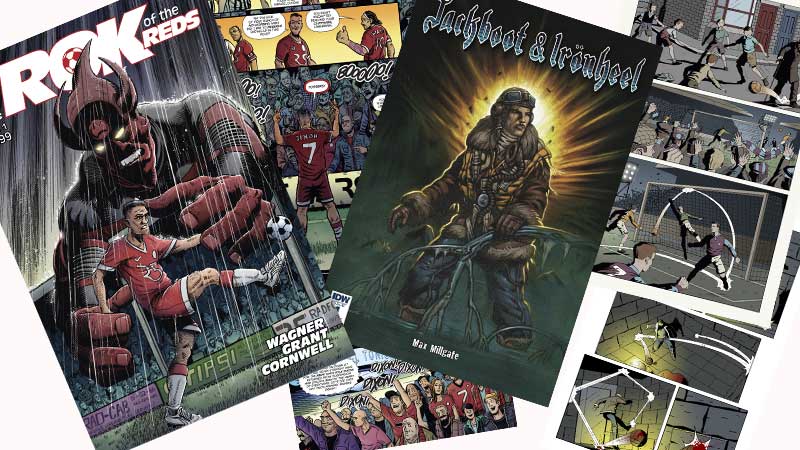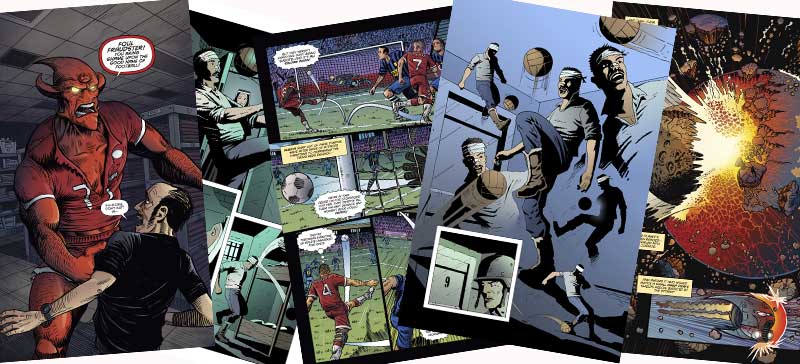
Merging football with science fiction and fantasy, Rok of the Reds and Jackboot and Ironheel have taken the genre way beyond Roy of the Rovers
2 February ~ Rebellion, the publishers of the long-running weekly 2000 AD, recently bought the considerable comic back catalogue of another publisher, IPC. One of the effects will be that Roy Race’s classic strips will soon be reprinted. But the creators of today’s football comics are venturing way beyond Roy of the Rovers’ traditional formulas, mixing football with other genres in order to appeal to modern-day audiences. While John Wagner and Dan Cornwell’s Rok of the Reds delves into science fiction territory, writer/artist David Millgate’s Jackboot and Ironheel finds a West Ham United striker from 1939 becoming embroiled in a ghostly conspiracy during the Second World War.
Best known for co-creating the legendary science fiction strip Judge Dredd, Wagner worked on some football stories while editing the weekly comic Valiant in the 1970s, and also wrote Dan Harker’s War, a story about football hooliganism, with former regular writing partner Alan Grant, for Roy of the Rovers in 1985. Wagner was looking for a new creator-owned project a couple of years ago when he chanced upon the treatment for what was originally called “Rom of the Rovers”. Teaming up with Brighton artist Dan Cornell, he took the six-issue series to Glasgow’s BHP Comics, who are publishing the fifth issue in January.
It opens with a fugitive shape-changing alien, Rok, landing on Earth. The title character then takes control of the body of bad-boy footballer Kyle Dixon, the star striker for the Radford Reds, a struggling lower-division club from “somewhere north of Manchester”. Previously maligned for his unruly behaviour, Kyle – aka Rok – undergoes a dramatic transformation on and off the pitch. With his goals propelling Radford into the semi-finals of the FA Cup, he even attracts the interest of Real Madrid, before his elaborate subterfuge inevitably attracts suspicion.
Conceding that “there has been a certain resistance to football stories among a few hardened comics fans, though those we get to sample the comic usually turn into converts”, Wagner believes that “a different type of marketing” is required if Rok of the Reds is to appeal to those interested in either comic books or football. Wagner has even contemplated selling copies of Rok of the Reds outside the grounds of several of the Football League clubs that play in red.

Also a regular contributor to 2000 AD, David Millgate is a childhood Liverpool supporter who has lived in Leicester for most of his life. Nonetheless, he concluded that West Ham were the only club that Jackboot and Ironheel’s main character Eddie Neale could conceivably play for. That Steve Harris – the bass player from one of Millgate’s favourite bands, Iron Maiden – is a lifelong Hammers fan was apparently also a factor. Published by San Diego-based IDW, the four-issue mini-series sees Neale go from playing “jumpers-for-goalposts” football on the London streets of the 1930s to wearing West Ham’s No 9 shirt. Nicknamed “Ironheel” after scoring “a jammy back-heel goal” on his debut, Eddie puts his professional career behind him as he becomes a gunner in the RAF.
Eddie’s love of football helps him endure both the real life and mystical horrors that he is caught up in. His footballing skills also come in handy when he is locked up in a Nazi prison castle, playing keepy-uppies in his cell in a sequence that emulates the scene in 1963’s The Great Escape, where a similarly incarcerated Steve McQueen continually bounces a baseball against the wall.
With the Upton Park of 1939 providing a stark contrast to the “champagne sipping and WAGS in executive boxes” of the London Stadium, Millgate affectionately illustrates the crowd standing on the terraces in caps and knitted scarves and was very careful with the 1930s football kits, with their considerably baggier shorts.
Admitting that “it was hard not ending up with just a Manchester United fantasy kit”, it was important to Cornwell for Radford’s strip to not be “too fussy” but still “look cool”. Realising that “a shirt sponsor can make or break a kit”, he came up with the “RS” logo, which stands for “Radford Steel”, before settling for red shirts and shorts with white trim and white socks with a red trim. “It couldn’t be red socks as that would look like Liverpool and being a United fan, that’s not going to happen,” he says. “I did a black away kit as well, but that hasn’t featured yet, so maybe we’ll save that for the second series.” Stephen Jewell
This article first appeared in WSC 360 ~ out now